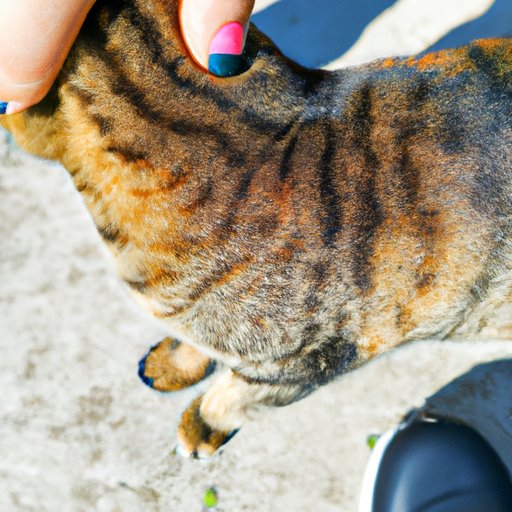Introduction
As pet owners, we always want to ensure that our furry friends are healthy and comfortable. It can be concerning when you notice your cat suddenly limping or favoring a paw. There are various reasons why a cat might be limping, and it could be difficult to identify the cause on your own. However, it’s essential to understand what might be causing your cat’s limping and how to manage it. This article will offer insights into the common medical conditions that cause limping, ways to prevent and manage them, and when to seek veterinary care.
A Medical Perspective
Limping in cats occurs when there is a problem with their bones, joints, or muscles, and it’s a common symptom of an underlying medical condition. While limping is usually due to an injury that can heal on its own, it is essential to consult your vet if you suspect an underlying medical condition may be the cause.
Medical conditions that can cause limping in cats include trauma, infections, arthritis, and neurological disorders. Trauma, such as getting hit by a car, can cause fractures, dislocations, or injuries to the joints and muscles. Infections can lead to injuries, abscesses, and inflammation. Arthritis, which usually occurs in older cats, can cause joint pain, stiffness, and limping. Neurological disorders affect the nervous system, leading to disruptions in motor control and coordination.
If your cat is limping, it is essential to observe other accompanying symptoms to identify the underlying medical condition. Some of the symptoms to look out for include fever, lethargy, loss of appetite, and difficulty moving around.
Common Causes of Limping in Cats
Several common causes of limping in cats include fractures, sprains, arthritis, and infections.
Fractures occur when a bone is broken and may result from an impact, jumping from high places, or accidents. Symptoms of fractures include difficulty moving the affected limb, sensitivity to touch, limping, swelling, and pain.
Sprains are injuries to ligaments, usually caused by overstretching or tearing of the tissues. Symptoms of sprains include limping, swelling, pain, and difficulty using the affected limb.
Arthritis is a degenerative disease that affects the joints and causes cartilage damage. Symptoms of arthritis include joint stiffness, limping, difficulty walking, and lethargy.
Infections such as abscesses or wounds can also cause limping. Symptoms of infections include swelling, sensitivity to touch, and pus formation.
Prevention
It’s important to take preventive measures to avoid your cat from limping. Some of the preventative measures include providing a balanced diet, exercise, and environmental enrichment. Cats that are overweight are more likely to suffer from joint problems and arthritis. Provide your cat with a balanced diet that meets their nutritional needs and avoids feeding them food that is toxic to them, such as grapes and chocolate.
Regular exercise is essential for your cat’s overall health and helps prevent obesity, which can lead to joint problems. You can provide your cat with indoor climbing structures and toys to encourage playtime and exercise.
Environmental enrichment, such as giving your cat puzzles and games, can help prevent boredom and provide mental stimulation for your cat.
Diagnosis
If your cat is limping, it is essential to take them to the vet for a diagnosis. The veterinarian will perform a physical examination and ask questions about your cat’s behavior and symptoms. They may recommend tests such as radiography and blood tests to identify the underlying medical condition.
If your cat is in severe pain and discomfort, it is essential to seek emergency veterinary care immediately.
Treatment
Treatment for limping in cats depends on the underlying medical condition. If your cat has a broken bone, your veterinarian may recommend surgery or splinting of the affected limb. Your cat may also require pain medication to relieve any discomfort and promote healing.
For sprains and strains, your veterinarian may recommend rest and anti-inflammatory medication to reduce swelling and promote healing.
If your cat has arthritis, your veterinarian will prescribe medication to reduce inflammation and pain. Physical therapy or weight management may also be recommended to help improve your cat’s mobility.
If your cat has an infection, your vet may prescribe antibiotics or perform surgery to remove any pus or abscesses.
It’s important to remain vigilant and monitor your cat’s behavior and response to treatment. Complications that may arise from treatment include poor surgical outcomes, failure to heal, and treatment resistance.
Conclusion
Limping in cats can be concerning, and it’s essential to identify the underlying medical condition to effectively manage it. Preventive measures such as a balanced diet, exercise, and environmental enrichment can help prevent limping in cats. Always seek veterinary help if your cat is limping, and follow your vet’s treatment plan closely. Remember to remain vigilant and note any significant changes in your cat’s behavior or condition.
Additional Resources
- https://www.petmd.com/cat/conditions/musculoskeletal/c_ct_limping
- https://catfriendly.com/cat-care-at-home/healthcare/cat-limping/
- https://www.thesprucepets.
